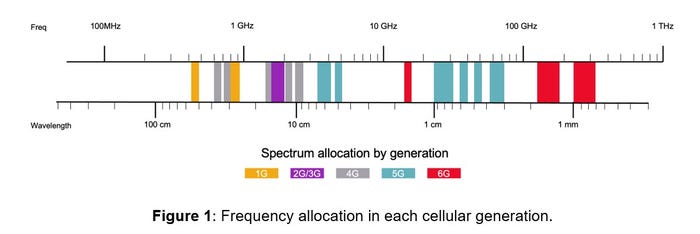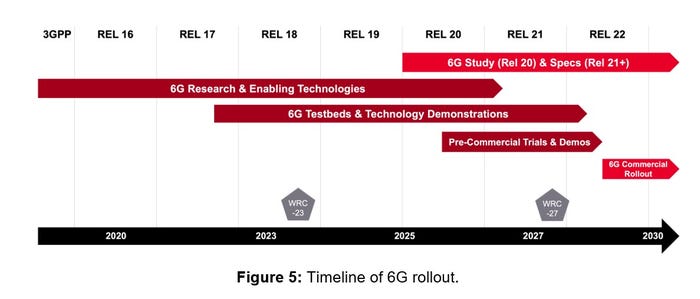Exploring the 6G Spectrum Landscape
6G will leverage many different bands and tools to meet the ever-growing demands and expectations for cellular communications.
September 7, 2023

New spectrum has been key to delivering new services, higher capacity, and faster data throughput rates in each new generation of cellular communications. The new spectrum that will be available for 6G remains unclear, but there are three frequency ranges under consideration. These ranges include the upper mid-band between 7-24 GHz, sub-THz bands between 90 GHz to 300 GHz, and maximizing spectrum below 7 GHz through re-farming, new band allocation, and increased spectral efficiency. Figure 1 shows spectrum allocation by generation, including potential bands for 6G. Each proposed band has benefits and drawbacks, as examined in detail below.

6g-1.jpg
6G Upper Mid-Band (7-24 GHz)
The spectrum between 7-24 GHz is the most appealing new spectrum for early 6G systems. The 7-15 GHz range is attractive for its propagation characteristics. At these frequencies, signals have less propagation loss, allowing for better penetration of buildings and other structures for indoor coverage. In this way, operators could increase network capacity without needing to add significant cell-site density.
The main challenge for using this spectrum in 6G is regulatory. The spectrum is fraught with both civilian and government incumbents that use it for applications other than fixed and mobile wireless access. Such applications include meteorology, radio astronomy, and maritime radio navigation. Many incumbents based on government or satellite communications will be difficult to relocate. Even if regulators can agree on spectrum availability and licensing schemes, the most challenging technical aspect involves how to share this spectrum without disrupting other users.

6g-2.jpg
6G Sub-THz Bands (90-300 GHz)
Sub-THz frequencies offer large, contiguous chunks of spectrum that could be allocated for 6G. Despite some technical challenges, these bandwidths deserve further research to potentially solve difficult problems such as space-to-Earth links, multi-dimensional visual and audio communications, and advanced communications and sensing applications.
The frequencies used in sub-THz remain an open question. The 90-110 GHz range (W band) has multiple segments with reasonable contiguous bandwidth allocated for mobile or fixed wireless. There are also larger contiguous bandwidths available in the 110-170 GHz D band, as shown in Figure 3.

6g-3.jpg
Other bands are allocated for mobile and fixed services above 200 GHz in the G and H bands, as shown in Figure 4. Use of these frequencies for commercial communications will arrive further out in the future than for the W or D band.

6g-4.jpg
The W and D band are the most likely sub-THz bands for initial use because of the relative maturity of the ecosystem at those frequencies and because of their more favorable propagation characteristics.
6G Lower Bands (Below 7 GHz)
The 600 MHz through 900 MHz bands will remain the mainstays of wide area coverage. These frequencies can cover the greatest distance with high outdoor-indoor penetration. They will continue to be important for rural deployments and will perform best when reaching the cell edge.
New spectrum will be obtained between 1-7 GHz for mobile and fixed wireless over the next five to ten years to help meet the throughput demands of 5G. Any new spectrum allocated in this band also will be leveraged by 6G.
Reexamining how spectrum in this band is used and re-farming it for new generations, as seen for the C band in 5G, is an example of how wider bandwidths can be obtained below 7 GHz. Spectrum in this frequency range is a scarce, finite resource that must be utilized in the most efficient ways possible.
Spectrum Timeline
The exact frequencies that 6G will use are unknown. The International Telecommunications Union allocates spectrum for International Mobile Telecommunications (IMT) at World Radio Conferences, or WRCs, which occur every four years. During a WRC, attendees identify frequency bands that could be used internationally for IMT to have global harmonization of spectrum while balancing the need to protect incumbents in bands of interest. Global spectrum harmonization is desirable because it enables an economy of scale for components and limits the number of bands that must be supported by user equipment.

6g-5.jpg
After IMT bands are identified, national regulators must allocate the bands for mobile service in their region. Bands are assigned through a variety of mechanisms - including, but not limited to - auctions, bidding, and direct license.
Conclusion
Based on current industry trends, 6G will leverage many different bands. The 7-15 GHz band is the most likely candidate for initial 6G deployments, but 6G must tap the already-allocated spectrum below 7 GHz as well. Improvements in dynamic spectrum-sharing are necessary to leverage all bands with the highest efficiency. The sub-THz bands, while not a target for 2030 deployments, still hold promise. These bands are seen as a target for a later phase of 6G, which will deploy closer to 2035-2040. By leveraging different spectrums and using different tools to provide various kinds of performance, 6G will be able to meet the ever-growing demands and expectations for cellular communications.
Sarah LaSelva is the director of 6G marketing at Keysight.
Related articles:
About the Author
You May Also Like




